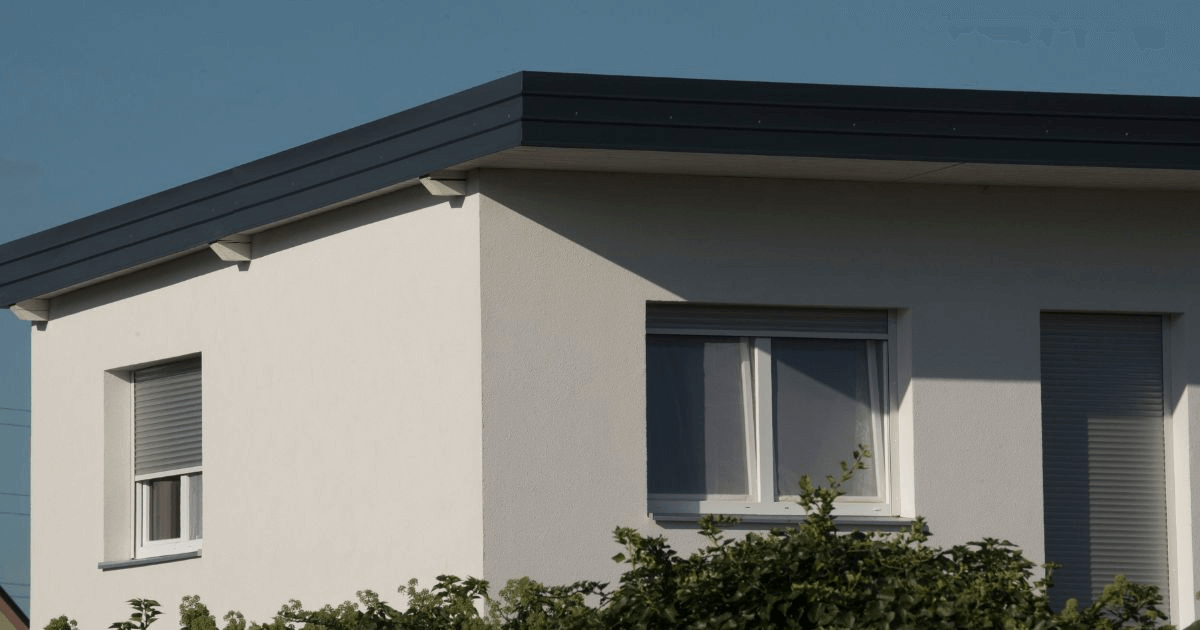Standing water on your flat roof spells trouble. This pooling water creates a cascade of problems that can damage your property, drain your wallet, and turn minor maintenance into major headaches. Understanding how to prevent water accumulation on your flat roof can save you thousands in repairs and significantly extend your roof’s lifespan.
Flat roofs face unique challenges that sloped roofs don’t encounter. Water naturally wants to flow downward, but flat surfaces don’t provide the gravity assist that traditional pitched roofs offer. This fundamental difference means flat roof owners must take proactive steps to manage water drainage and prevent the costly consequences of standing water. Here’s how to avoid standing water on your flat roof.
A Flat Roof’s Water Management Challenges
Flat roofs aren’t completely flat, despite their name. Most flat roofs have a slight slope of about 1/4 inch per foot to encourage water drainage. However, this minimal slope makes them vulnerable to water pooling when drainage systems fail or when the roof structure settles over time.
Materials Used
The materials used in flat roof construction also affect water management. Single-ply membranes, built-up roofing, and modified bitumen all respond differently to water exposure. Some materials handle occasional water pooling better than others, but none perform well when water sits for extended periods.
Temperature Fluctuations
Temperature fluctuations create additional challenges for flat roofs. Water expands when it freezes, creating pressure that can crack roofing materials and damage the underlying structure. Even in warmer climates, standing water accelerates membrane deterioration, creating conditions that allow algae and moss to thrive.
Root Causes of Standing Water
Poor drainage design ranks as the leading cause of standing water problems. When architects or contractors fail to plan adequate drainage, water has nowhere to go during heavy rainfall. Insufficient drain placement, undersized drainage systems, or inadequate slope calculation all contribute to this problem.
Blocked drainage systems create water backup that leads to pooling. Leaves, debris, sediment, and even small animals can clog drains and gutters. Regular storms deposit organic matter on roofs, and without consistent cleaning, this debris accumulates and blocks water flow.
Structural settling affects drainage over time. Buildings naturally settle as they age, and this settling can alter the roof’s slope. Areas that once drained properly may develop slight depressions, which can trap water. Heavy equipment placement or foot traffic can also create low spots that collect water.
Improper installation creates immediate drainage problems. When roofing contractors don’t follow manufacturer specifications for slope requirements or drain placement, water pooling becomes inevitable. Inadequate membrane installation can also create areas where water penetrates and causes underlying damage.
Regular Roof Inspections
Monthly roof inspections help you catch drainage problems before they become major issues. Walk your roof after heavy rainstorms to identify areas where water collects. Mark these spots and monitor them over time to determine if the problem worsens.
Examine and Test
Check all drainage components during your inspections. Examine drains, gutters, downspouts, and scuppers for signs of blockage or damage. Inspect for signs of rust, cracks, or separations that could compromise drainage function. Make sure you test the drain flow by pouring water directly into each drain to verify proper operation.
Documentation
Document problem areas with photographs and notes. This documentation helps you track changes over time and provides valuable information for roofing contractors when you need professional assistance. Create a simple inspection checklist to maintain consistency in your evaluations.
Weather Problems
Weather monitoring helps you anticipate potential problems. Pay attention to local weather forecasts and plan additional inspections after severe storms have passed. Heavy rainfall, hail, or high winds can damage drainage systems or deposit debris that blocks water flow.
Effective Drainage System Maintenance
Clean your drainage systems at least twice a year, preferably in the spring and fall. Remove all debris from drains, gutters, and downspouts. Use a garden hose to flush systems and verify proper water flow. Pay special attention to areas where leaves and organic matter tend to accumulate.
Trim vegetation around your building to reduce debris accumulation on your roof. Overhanging branches drop leaves, twigs, and other organic matter that can clog drainage systems. Maintaining a clear space around your building also improves air circulation, which helps your roof dry more quickly after storms.
Install drain strainers or leaf guards to prevent debris from entering your drainage system. These simple devices catch larger debris while allowing water to flow freely. Clean strainers regularly to maintain their effectiveness.
Consider upgrading undersized drainage systems. If your roof consistently develops standing water despite regular cleaning, your drainage system may lack adequate capacity. A roofing professional can calculate proper drainage requirements and recommend system improvements.
DIY Solutions for Minor Water Pooling Issues
Address minor drainage problems promptly to prevent them from becoming major issues. You can resolve small amounts of standing water with simple solutions that don’t require professional intervention.
Quick Debris Removal
Remove debris immediately after storms. Don’t wait for scheduled maintenance if you notice significant debris accumulation. Quick removal prevents drainage blockages and reduces the risk of water pooling during the next rainfall.
Roof Coatings
Apply roof coatings to minor low spots where water tends to collect. Elastomeric coatings can fill small depressions and create a more uniform surface, promoting drainage. Choose coatings specifically designed for your roof membrane type.
DIY Water Flow Redirect
Redirect water flow using temporary solutions when necessary. Squeegees or push brooms can help move standing water toward drains after storms. While this isn’t a permanent solution, it prevents water from sitting on your roof while you arrange for proper repairs.
Maintain Drainage Components
Clean and adjust existing drainage components. Sometimes gutters or downspouts need repositioning or cleaning to improve drainage. Check for loose connections or misaligned components that impair water flow.
Professional Intervention for Serious Drainage Problems
Extensive standing water requires professional assessment and repair. When water covers large areas of your roof or persists for more than 48 hours after rainfall, contact a qualified roofing contractor immediately. These conditions indicate serious drainage problems that DIY methods cannot resolve.
Structural modifications may be necessary to correct drainage issues. Adding drains, installing tapered insulation systems, or adjusting roof slope requires professional expertise and specialized equipment. Attempting these modifications without proper training can cause more damage than the original problem.
Common flat roof problems like membrane damage, structural deterioration, or major drainage system failures require professional attention. Roofing contractors possess the necessary tools, materials, and expertise to diagnose complex problems and implement long-lasting solutions.
Emergency water removal services become necessary when standing water threatens your building’s interior. Professional contractors can quickly remove large volumes of water and implement temporary drainage solutions while planning permanent repairs.
Protecting Your Investment
Standing water on your flat roof creates expensive problems that proper maintenance can prevent. Regular inspections, prompt debris removal, and professional maintenance when needed will keep your roof functioning properly for years to come.
Take action now to assess your roof’s drainage performance. Schedule a professional inspection if you’ve noticed any signs of standing water or drainage problems. The small investment in preventive care will pay dividends in extended roof life and avoided repair costs.





















